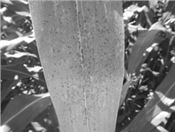Managing Southern Rust In Corn
DR. KIERSTEN WISE
PRINCETON, KEN.
Southern rust of corn, caused by the fungus Puccinia polysora, was confirmed in Kentucky on July 12, in Union County. The disease was at very low incidence and severity; however with our current weather conducive for disease development, it will not be surprising to see additional confirmations across the state. It will be important to scout and monitor fields over the next few weeks and submit samples to the Plant Disease Diagnostic Laboratory (PDDL) through local county Extension agents if you suspect you have southern rust in a field.
Identifying Southern Rust
Southern rust is first observed as raised, dusty orange pustules on the upper surface of the leaf (Figure 1). Pustules will typically be present only on the upper surface of the leaf. The disease is easily confused with common rust, which produces pustules on both sides of the leaf. Common rust (Puccinia sorghi), can be found sporadically in Kentucky corn fields and is not economically important to manage, so it is important to distinguish between the two diseases before applying fungicide. If southern rust is suspected, the fastest way to get a diagnosis through the PDDL is to submit samples through county agents. Confirmations of southern rust will be posted on the cornipmpipe website. On the map, red counties/parishes indicate that southern rust has been confirmed by university/Extension personnel.
Disease Impact
The potential impact of southern rust in Kentucky will depend on the crop growth stage of a field once southern rust is confirmed in an area. Previous research from southern states indicates that fungicides may be needed to protect yield while corn is in the tasseling through milk (VT-R3) growth stages. Once corn is past milk (R3), fungicides are likely not needed to manage the disease. If fields have already received a fungicide application this year at tasseling/silking (VT/ R1), they are not likely to need a second application of fungicide once corn reaches the blister (R2) growth stage. Fields that were sprayed pre-tassel (V10-V14) should be scouted carefully to determine disease presence and progression, and to determine if an additional fungicide application is needed.
Very late-planted fields of high-value corn that is still pre-tassel should be scouted to determine if the disease is present before deciding on a fungicide application. Fungicide application may be beneficial in certain fields of late-planted corn, but this should be determined on a case-by-case basis.
Additional Information
More information on timing of fungicide applications for southern rust can be found in Table 2 of the Crop Protection Network publication Southern Rust, which can be read here.
The efficacy of specific fungicide products for southern rust are described in the updated fungicide efficacy table for management of corn diseases, which is developed by the national Corn Disease Working Group, and posted on the Crop Protection Network website. ∆
DR. KIERSTEN WISE: Plant Pathology Extension Specialist, University of Kentucky

Figure 1. Southern rust on corn
(Photo: Kiersten Wise, UK)